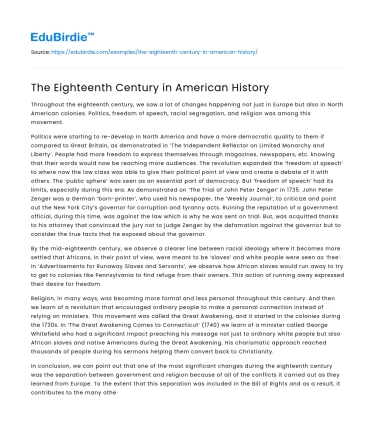Throughout the eighteenth century, we saw a lot of changes happening not just in Europe but also in North American colonies. Politics, freedom of speech, racial segregation, and religion was among this movement.
Politics were starting to re-develop in North America and have a more democratic quality to them if compared to Great Britain, as demonstrated in ‘The Independent Reflector on Limited Monarchy and Liberty’. People had more freedom to express themselves through magazines, newspapers, etc. knowing that their words would now be reaching more audiences. The revolution expanded the ‘freedom of speech’ to where now the low class was able to give their political point of view and create a debate of it with others. The ‘public sphere’ was seen as an essential part of democracy. But ‘freedom of speech’ had its limits, especially during this era. As demonstrated on ‘The Trial of John Peter Zenger’ in 1735. John Peter Zenger was a German ‘born-printer’, who used his newspaper, the ‘Weekly Journal’, to criticize and point out the New York City’s governor for corruption and tyranny acts. Ruining the reputation of a government official, during this time, was against the law which is why he was sent on trial. But, was acquitted thanks to his attorney that convinced the jury not to judge Zenger by the defamation against the governor but to consider the true facts that he exposed about the governor.
Save your time!
We can take care of your essay
- Proper editing and formatting
- Free revision, title page, and bibliography
- Flexible prices and money-back guarantee
By the mid-eighteenth century, we observe a clearer line between racial ideology where it becomes more settled that Africans, in their point of view, were meant to be ‘slaves’ and white people were seen as ‘free’. In ‘Advertisements for Runaway Slaves and Servants’, we observe how African slaves would run away to try to get to colonies like Pennsylvania to find refuge from their owners. This action of running away expressed their desire for freedom.
Religion, in many ways, was becoming more formal and less personal throughout this century. And then we learn of a revolution that encouraged ordinary people to make a personal connection instead of relying on ministers. This movement was called the Great Awakening, and it started in the colonies during the 1730s. In ‘The Great Awakening Comes to Connecticut’ (1740) we learn of a minister called George Whitefield who had a significant impact preaching his message not just to ordinary white people but also African slaves and native Americans during the Great Awakening. His charismatic approach reached thousands of people during his sermons helping them convert back to Christianity.
In conclusion, we can point out that one of the most significant changes during the eighteenth century was the separation between government and religion because of all of the conflicts it carried out as they learned from Europe. To the extent that this separation was included in the Bill of Rights and as a result, it contributes to the many other changes on the social aspects and political participation in the colonies.






 Stuck on your essay?
Stuck on your essay?

